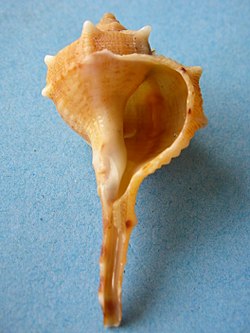| Bolinus brandaris Temporal range: | |
|---|---|
 | |
| Two shells of the spiny dye-murex | |
| Scientific classification | |
| Kingdom: | Animalia |
| Phylum: | Mollusca |
| Class: | Gastropoda |
| Subclass: | Caenogastropoda |
| Order: | Neogastropoda |
| Family: | Muricidae |
| Genus: | Bolinus |
| Species: | B. brandaris |
| Binomial name | |
| Bolinus brandaris | |
Bolinus brandaris (originally called Murex brandaris by Linnaeus and also Haustellum brandaris), and commonly known as the purple dye murex or the spiny dye-murex, is a species of medium-sized predatory sea snail, an edible marine gastropod mollusk in the family Muricidae, the murex snails or the rock snails. [1]
Contents
- Distribution and habitat
- Human use
- Biology
- Shell
- Species
- Synonyms
- See also
- References
- Further reading
This species is known in the fossil record from the Pliocene (age range: from 3.6 to 2.588 million years ago). Fossil shells of this species have been found in Cyprus, Spain and Italy. [2] It was used by the Phoenicians in ancient times to extract imperial Tyrian purple dye. [3]






